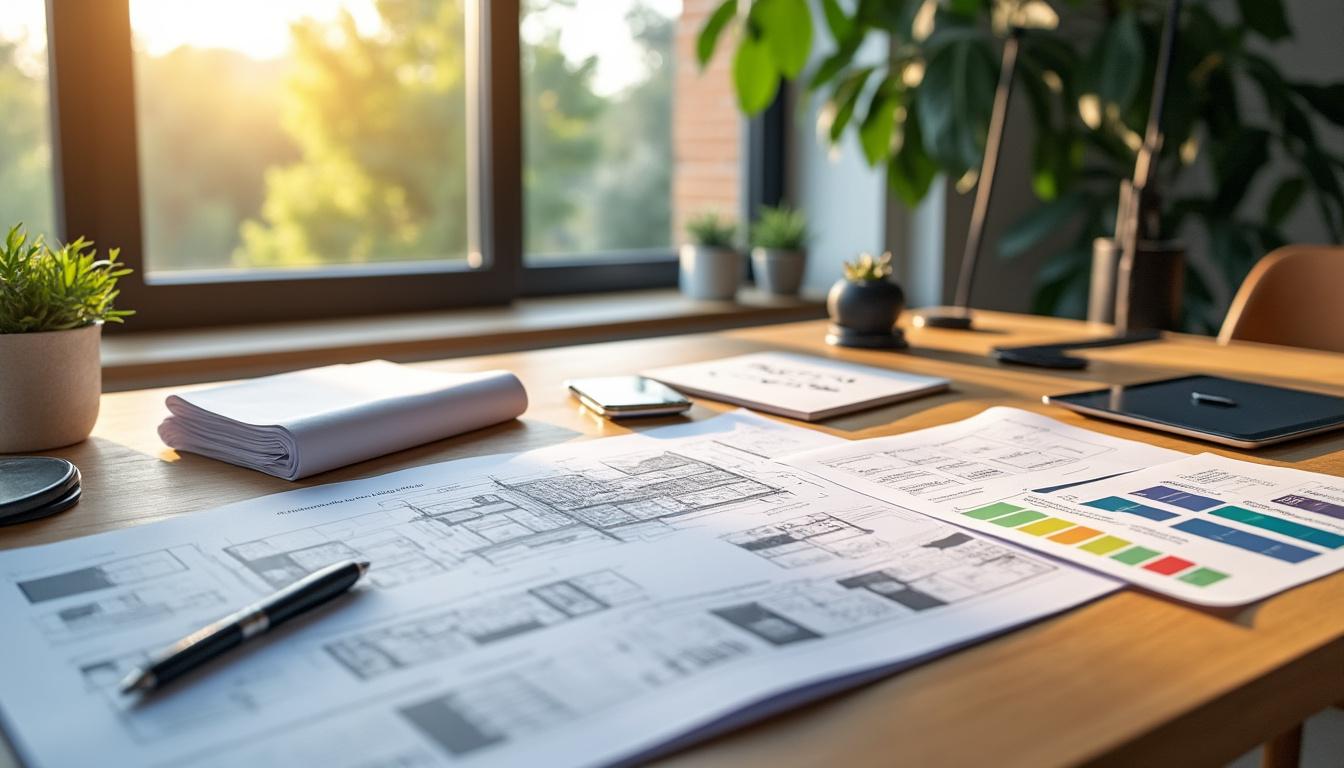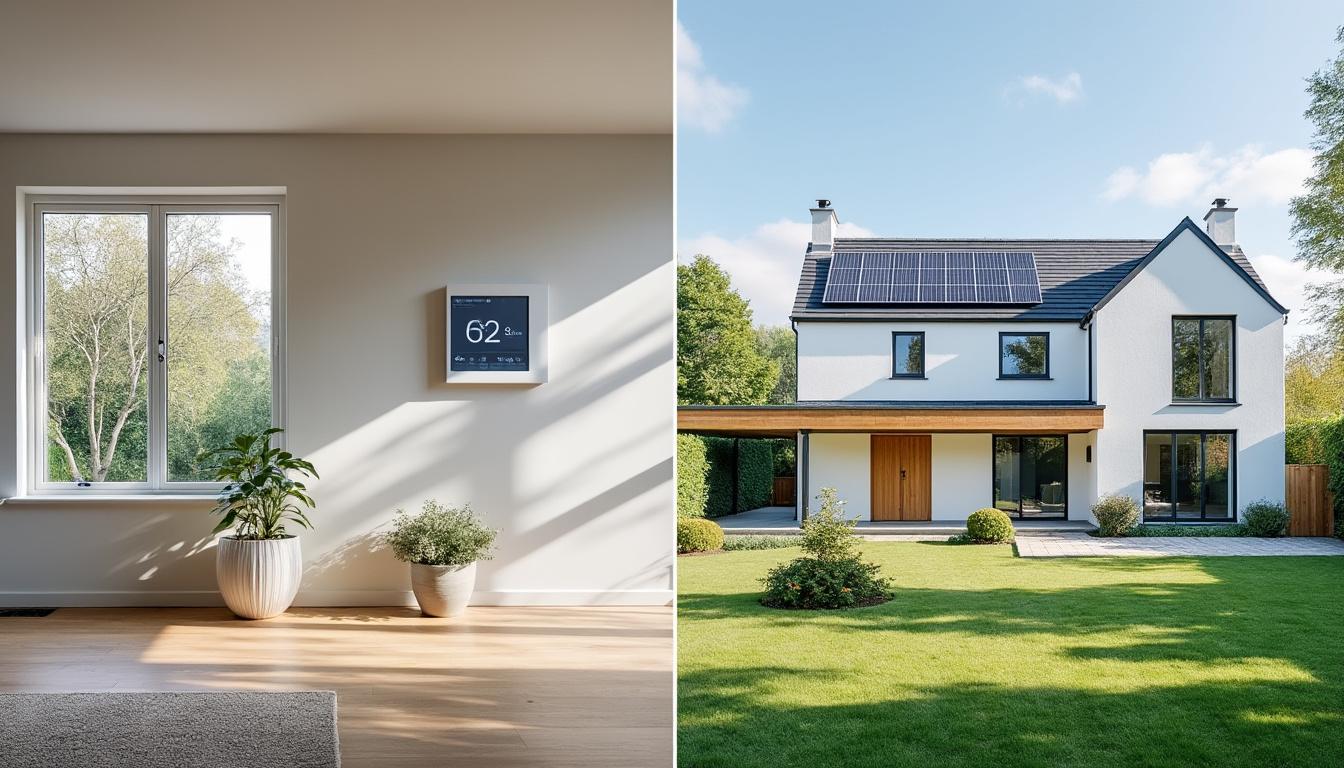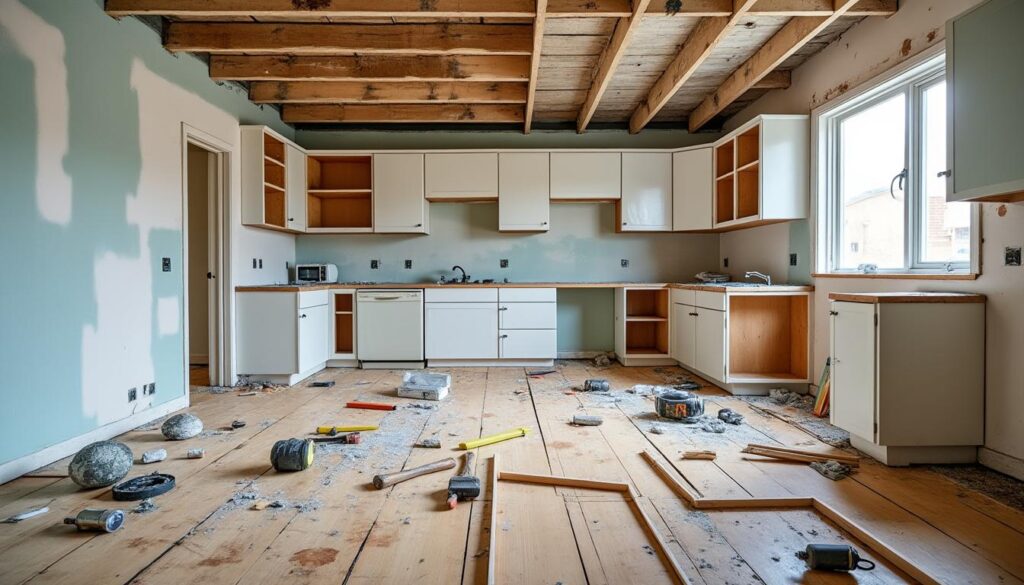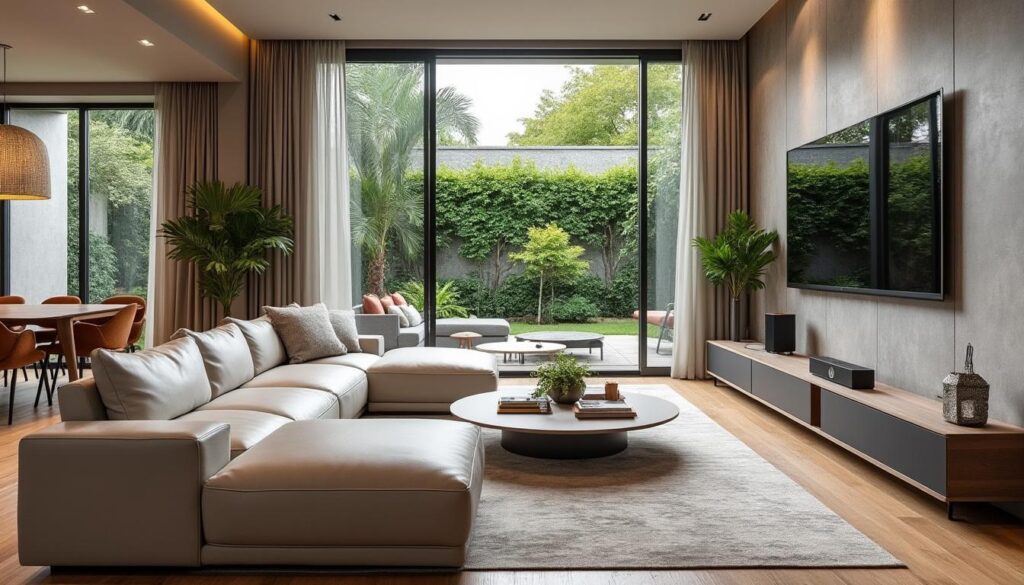Renovating with awareness is transforming your home into a more comfortable, healthy, and economical space without waste. This step-by-step guide combines practical strategies for a sustainable and efficient renovation, from the idea to the completed work.
| Short on time? Here’s the essence: |
|---|
| ✅ Set goals and priorities before starting: energy efficiency, material health, comfort, and budget 💡 |
| ✅ Invest first in the thermal envelope (insulation, efficient windows) to reduce heating/cooling consumption ❄️🔥 |
| ✅ Integrate smart technologies (VMC, aerothermal, LED, thermostats) with simple automation for real savings ⚙️ |
| ✅ Avoid the common mistake: choosing finishes before planning the performance (thermal bridges, ventilation, natural light) 🚫 |
| ✅ Bonus: utilize rainwater and perform selective demolition to reduce waste and costs ♻️💧 |
Smart planning: the step-by-step that reduces costs and waste
A sustainable renovation starts on paper. A clear plan avoids rework, guides material choices, and ensures that every euro invested increases performance and comfort. Before the first demolition, it’s worthwhile to map out needs, define metrics, and foresee phases, if necessary.
Energy diagnosis and practical priorities
Conducting a simple energy diagnosis provides an accurate picture of the house: air leaks, thermal bridges, solar orientation, shading, and outdated equipment. Tools like thermal cameras, consumption meters, and blower-door tests (when accessible) reveal where to attack first.
Based on this picture, priorities become clear: envelop the house with continuous insulation, seal air leaks, improve windows, optimize ventilation, and only then replace systems. This sequence maximizes savings and avoids oversizing equipment.
- 🧭 Conduct a thermal check-up: roof, walls, and floors are the biggest loss surfaces.
- 🌞 Analyze orientation: enhance shading to the west and capture light to the south.
- 🪟 Check frames: air permeability and glass suitable for the climate.
- 🌬️ Confirm air renewal: VMC prevents damp and mold.
Budget, phases, and return on investment
It is common to divide the work into stages. An effective strategy is to invest first in the envelope (insulation + windows), then in ventilation, and finally in climate control and renewable energy. This way, the final systems will be smaller and cheaper, with a payback that is quicker.
- 🎯 Define measurable objectives: reduce consumption by 40–60%, improve indoor air quality.
- 📊 Estimate ROI: cross-check the cost of each measure with the expected annual savings.
- 🧱 Phase without waste: plan technical passages and fixing points from the start.
| Measure 🔧 | Energy Impact ⚡ | Relative Cost 💶 | Return ⏱️ | Key Note 🌿 |
|---|---|---|---|---|
| Roof insulation | High (25–35%) | Medium | 2–5 years | Tackles the biggest heat loss 🏠 |
| Windows with thermal break | High (15–25%) | High | 5–10 years | Comfort + acoustics 🎧 |
| Low-consumption VMC | Medium (5–12%) | Medium | 3–6 years | Indoor air health 💨 |
| LED + sensors | Medium (8–15%) | Low | 1–2 years | Quick gains 💡 |
Final insight: prioritizing the envelope before technology avoids duplicate spending and maximizes the overall efficiency of the project.

Sustainable materials: healthy choices that enhance performance
The quality of materials defines comfort, durability, and the health of the indoor environment. Choosing solutions with low embodied energy, responsible sourcing, and minimal VOC emissions improves performance and air quality.
Efficient and ecological insulators
In Atlantic climates, the combination of thermal resistance and hygrothermal behavior is critical. Insulators such as rock wool and cellulose (recycled) provide good thermal and acoustic performance, while polyurethane works well in difficult areas. In Portugal, expanded cork stands out locally, being 100% natural and excelling in thermal bridge performance.
- 🧱 Cellulose: great cost-benefit and recycling of paper ♻️.
- 🪵 Cork: national production, resistant to moisture and fungi.
- 🪨 Rock wool: high acoustic protection and fire resistance.
- 🧊 Sprayed PU: seals cavities and reduces air infiltration.
Healthy and circular finishes
Mineral and water-based paints with low VOC reduce emissions and odors. Floors in certified wood, bamboo, or phthalate-free vinyl reduce the footprint and increase tactile comfort. Whenever possible, prefer certified woods and recycled coatings.
- 🎨 Eco-friendly paints: fewer odors and better indoor air quality.
- 🪑 Certified wood panels (FSC/PEFC): durability and traceability.
- 🧼 Washable and durable coatings: simpler maintenance and longer lifespan.
| Material 🧰 | Origin/Certification 📜 | Conductivity (W/m·K) 📐 | VOC/Air Quality 🌬️ | Circularity ♻️ |
|---|---|---|---|---|
| Expanded cork | Local, renewable 🌿 | 0.038–0.045 | Very low ✅ | High (reusable) 🔄 |
| Cellulose | Recycled ♻️ | 0.038–0.042 | Low ✅ | High (recyclable) 🔁 |
| Rock wool | Mineral ⛰️ | 0.035–0.040 | Low ✅ | Medium (recycling) ♻️ |
| Mineral paint | Water-based 💧 | — | Very low ✅ | High (long-lasting) ⏳ |
Realistic example: in a T2 apartment in Lisbon, replacing old PVC with thermal break frames and applying cork on the ceiling reduced urban noise and improved winter comfort, with clean works and no persistent smell. The sensory and thermal gain is immediate and lasting.
Final insight: the right materials bring comfort and health today, and energy savings tomorrow.
Efficient technologies: integrating renewable energy and simple automation
After reinforcing the envelope and choosing healthy materials, technology multiplies results. Well-sized systems and straightforward automation reduce consumption without sacrificing comfort.
Climate control, low-consumption ventilation, and electricity
Aerothermal heat pumps cover heating, cooling, and DHW with high efficiency, especially when the envelope is already optimized. In houses, geothermal is a stable option, although with more intrusive work. VMC (controlled mechanical ventilation) with heat recovery keeps the air healthy and reduces thermal losses.
- ⚡ LED and sensors: presence and natural light to automatically regulate intensity.
- 📱 Smart thermostats: programming by schedules and geofencing.
- 🔆 Solar PV and solar thermal: self-consumption and DHW with sun, reducing bills.
- 🔌 Smart plugs: cut standby and monitor consumption.
| Technology ⚙️ | Estimated savings 📉 | Average payback ⏳ | Additional benefit 🌟 |
|---|---|---|---|
| Aerothermal heat pump | 30–50% vs. resistance | 4–8 years | DHW + annual comfort ❄️🔥 |
| VMC with recovery | 5–12% overall | 3–6 years | Less humidity and mold 💨 |
| Photovoltaic solar | 20–40% electricity | 5–9 years | Self-consumption ☀️ |
| LED + dimming | 60–80% lighting | 1–2 years | Visual comfort 👀 |
Automation that works for you
Automating simple routines prevents waste: reducing setpoint at night, turning off HVAC when windows open, or adjusting light based on presence. There is no need for a complex “smart home”; modular solutions do what’s essential and scale in the future.
- 🧠 Basic scenarios: “Out of home,” “Night,” “Comfort.”
- 🕒 Timers and sensors: combine natural light with presence.
- 📈 Monitoring: plugs with measurement to eliminate hidden consumption.
Want to see this in action? Search for demonstration videos with examples of efficient homes and simple modular solutions.
Final insight: technology only delivers on its promise when the envelope is strong, and automation is simple.

Thermal envelope and natural light: passive comfort that saves energy
The cheapest comfort comes from passive solutions: insulate, seal, capture sun in winter, and protect from excess in summer. By optimizing windows, shading, and natural light, you reduce reliance on machines and improve daily well-being.
High-performance windows and doors
Choosing frames with thermal break and double/triple glazing suitable for the climate is crucial. Proper installation, with sealing tapes and thermal sills, prevents infiltration and condensation. In noisy streets, acoustic interleaving significantly increases sound comfort.
- 🪟 Low-emissivity glass to the north and west to reduce unwanted losses and gains.
- 🧵 Perimeter seals and placement on thermal plane to eliminate bridges.
- 🔧 Airtightness tests improve heating/cooling results.
Daylight, shading, and layout
Plan social spaces on the brightest sides and create free visual axes. Brises, exterior blinds, and awnings reduce overheating in summer without darkening the house. Skylights with diffusers and solar tubes are allies in deep interior areas.
- 🌞 Maximize light to the south in winter; protect the west in summer.
- 🪑 Open layouts with light surfaces to reflect natural light.
- 🧱 Colors and materials with high light reflection index (LRV) on ceilings.
| Passive Measure 🧱 | Thermal Effect 🌡️ | Comfort 🎯 | Notes 🔍 |
|---|---|---|---|
| Exterior shading | -3 to -6 ºC in summer | Reduced glare 👓 | Automated brises and blinds ⏱️ |
| Diffused skylight | Less artificial light | Homogeneous environment 🌤️ | Condensation control 💧 |
| Sealing of frames | Less infiltration | Warm in winter ❄️ | Appropriate tapes and membranes 🧵 |
For inspiration from passive solutions applied in a real context, there are excellent demonstrations in construction visits and technical tours.
Final insight: the right light and shading reduce machines and increase well-being throughout the year.
Water, waste, and conscious construction: complete project efficiency
Efficiency does not end with energy. Caring for water, managing construction waste, and ensuring quality execution make the renovation truly sustainable. Every gesture saved during construction reflects on comfort and bills for decades.
Water conservation and reuse
Installing fixtures with low flow, dual-flush toilets, and thermostatic mixers reduces consumption without sacrificing comfort. In houses and ground floors, rainwater harvesting systems supply toilets and irrigation. Efficient irrigation with scheduling and native plants drastically reduces water needs.
- 💧 Showers and faucets 6–9 L/min with aerators.
- 🚽 Toilet 3/6 L dual flush.
- 🌧️ Rainwater tank for irrigation and cleaning.
- 🌿 Low-maintenance gardens with native species.
Selective demolition and responsible purchasing
Selective demolition separates waste and allows for the reuse of doors, hardware, and tiles. Buying to measure and planning cuts reduces leftovers. Negotiating with certified suppliers and optimizing logistics reduces transport footprints.
- 🗂️ Waste plan by type (C&D): inert, metals, wood, plastics.
- 🔁 Local reuse: doors and toilets for donation or resale.
- 📦 Packaging: prefer returnable and recycled materials.
| Measure 💡 | Estimated savings 📉 | Complexity 🧩 | Practical tip 🛠️ |
|---|---|---|---|
| Reuse of doors | Up to 100% of the item | Low | Sand + eco-friendly paint 🎨 |
| Purchase by measure | 5–10% of cost | Medium | Cutting plans 📐 |
| Waste separation | Lower rates | Medium | Dedicated containers 🧭 |
Measurement, verification, and maintenance
After the work, it’s time to confirm results. Monitoring bills and consumption readings, adjusting HVAC schedules, and checking VMC filters ensure that projected performance becomes reality. A semi-annual review keeps everything in tune.
- 📈 Simple KPIs: kWh/m², L/day of water, hours of VMC.
- 🧽 Filters: replace every 6–12 months depending on use.
- 🛎️ Alerts: maintenance and cleaning schedule.
An immediate gesture that works: install aerators on faucets and adjust the night setpoint of heating. Small decisions, big savings.
Brief case study: Silva family
In a renovation in an 85 m² T2, the Silva family prioritized roof insulation (10 cm cellulose), low-consumption VMC, LED with sensors, and smart thermostats. They then replaced windows with thermal break models and low-emissivity glass. Annual consumption dropped by about 42%, and complaints of condensation disappeared. The investment will pay for itself in 6–7 years, with notably superior daily comfort.
| Applied Measure 🏡 | Measured Result 📊 | Comfort Perception 😌 | Work Tip 👷 |
|---|---|---|---|
| Roof insulation | -22% heating | More stable rooms 🌙 | Work without excessive dust 🧹 |
| VMC | -8% overall | Cooler air 💨 | Ducts accessible for maintenance 🔧 |
| LED + sensors | -12% lighting | Uniform light 💡 | Calibrate presence times ⏱️ |
To deepen concepts and solutions, it’s worth exploring technical content and practical examples on reference platforms like Ecopassivehouses.pt, always focusing on applicable and accessible measures for everyday life.
{“@context”:”https://schema.org”,”@type”:”FAQPage”,”mainEntity”:[{“@type”:”Question”,”name”:”How much does a sustainable renovation cost compared to a traditional one?”,”acceptedAnswer”:{“@type”:”Answer”,”text”:”The initial investment tends to be higher due to materials and efficient technologies, but the savings in energy, maintenance, and indoor health compensates in the medium term. Addressing the envelope first reduces the power requirement of equipment, shortening the payback.”}},{“@type”:”Question”,”name”:”What materials should be prioritized for insulation and finishes?”,”acceptedAnswer”:{“@type”:”Answer”,”text”:”Insulators like cork, cellulose, and rock wool balance thermal and acoustic performance with low toxicity. For finishes, choose mineral/water-based paints with low VOC and certified woods, ensuring healthy indoor air and durability.”}},{“@type”:”Question”,”name”:”Is it essential to install solar panels?”,”acceptedAnswer”:{“@type”:”Answer”,”text”:”No. First optimize the envelope and ventilation; then evaluate photovoltaic or thermal solar based on consumption and orientation. In many cases, the combination of LED, VMC, and a well-sized heat pump already offers a strong reduction in bills.”}},{“@type”:”Question”,”name”:”How to avoid endless works and budget overruns?”,”acceptedAnswer”:{“@type”:”Answer”,”text”:”Define a clear scope, schedule by phases, and decision points. Plan technical passages and detail the installation (tapes, membranes, insulation thicknesses). Monitor measurements and validate each step before moving on to the next.”}}]}How much does a sustainable renovation cost compared to a traditional one?
The initial investment tends to be higher due to materials and efficient technologies, but the savings in energy, maintenance, and indoor health compensates in the medium term. Addressing the envelope first reduces the power requirement of equipment, shortening the payback.
What materials should be prioritized for insulation and finishes?
Insulators like cork, cellulose, and rock wool balance thermal and acoustic performance with low toxicity. For finishes, choose mineral/water-based paints with low VOC and certified woods, ensuring healthy indoor air and durability.
Is it essential to install solar panels?
No. First optimize the envelope and ventilation; then evaluate photovoltaic or thermal solar based on consumption and orientation. In many cases, the combination of LED, VMC, and a well-sized heat pump already offers a strong reduction in bills.
How to avoid endless works and budget overruns?
Define a clear scope, schedule by phases, and decision points. Plan technical passages and detail the installation (tapes, membranes, insulation thicknesses). Monitor measurements and validate each step before moving on to the next.


